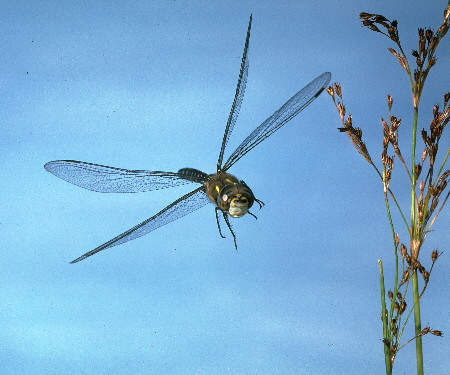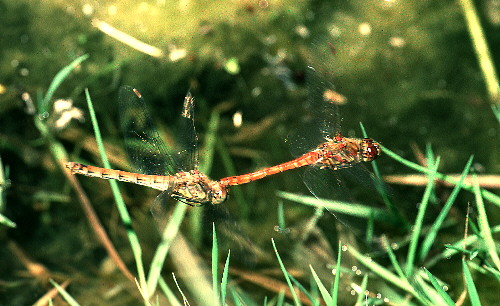Return to moorhen home
page
Dragonflies in
Flight
 Dragonflies are the UK's largest insects. They
are also some of the most primitive of insects,
very early fossils being very similar except that
some early dragonflies were HUGE, having
60cms wingspan. This is a typical Hawker
Dragonfly with a wingspan of about 10cm.
Dragonflies were the first creature to use our
ponds for breeding - they arrived and started
laying while the first pond had only been filling
for a day. Ever after the pond has been
known as 'Dragon Pool'.
Dragonflies are the UK's largest insects. They
are also some of the most primitive of insects,
very early fossils being very similar except that
some early dragonflies were HUGE, having
60cms wingspan. This is a typical Hawker
Dragonfly with a wingspan of about 10cm.
Dragonflies were the first creature to use our
ponds for breeding - they arrived and started
laying while the first pond had only been filling
for a day. Ever after the pond has been
known as 'Dragon Pool'.
These insects form a family of insects of
increasing size through Damselflies, Darter
Dragonflies and Hawker Dragonflies. All are
exclusively carnivorous in all stages of life. The
insects live as nymphs for 2 or 3 years
underwater, preying on tadpoles, small fish
and other dragonfly nymphs and similar. They
emerge on a summer morning by crawling up
a reed, splitting the nymph case and crawling out,
pumping up their beautiful wings. In this new form they
live the rest of
their life looking for things to kill and eat, but add
to this finding a mate. Eggs are laid in the water,
some species laying 'in
tandem' with the male in front holding the female by
the scruff of her neck using claspers at his rear.
Male Darter and Hawker dragonflies are extremely
territorial, guarding an area that seems to be typically
100 square
meters. They fight on the wing any intruder that they
are not interested in mating with, whatever the species.
They chiefly
hunt midges, flies and similar, but can cope with small
butterflies, though larger butterflies (e.g. Peacock) seem
to be
strong enough to escape. They will suddenly shoot upward
while patrolling, grab a tiny speck out of the sky, and
then
return to patrolling while sucking the juices out of
their prey, dropping the bits when they have finished.
We are trying to
photograph hunting or fighting activity but the prospects
don't look good!
The top picture thought to be a Migrant Hawker
dragonfly in free flight, taken by flash triggered by
breaking an infrared
beam. If you like such photographs look for books and
pictures by Stephen Dalton who showed the world how to
raise
such photography to an art form. He mostly photographs
large tropical exotica - we have designed our equipment
for
more typical UK sized subjects.
 The lower picture is of
a pair of
Common darter Dragonflies
'in-tandem' laying eggs taken at the
edge of one of our ponds. This was
taken hand held with Flash.
The lower picture is of
a pair of
Common darter Dragonflies
'in-tandem' laying eggs taken at the
edge of one of our ponds. This was
taken hand held with Flash.
 Dragonflies are the UK's largest insects. They
are also some of the most primitive of insects,
very early fossils being very similar except that
some early dragonflies were HUGE, having
60cms wingspan. This is a typical Hawker
Dragonfly with a wingspan of about 10cm.
Dragonflies were the first creature to use our
ponds for breeding - they arrived and started
laying while the first pond had only been filling
for a day. Ever after the pond has been
known as 'Dragon Pool'.
Dragonflies are the UK's largest insects. They
are also some of the most primitive of insects,
very early fossils being very similar except that
some early dragonflies were HUGE, having
60cms wingspan. This is a typical Hawker
Dragonfly with a wingspan of about 10cm.
Dragonflies were the first creature to use our
ponds for breeding - they arrived and started
laying while the first pond had only been filling
for a day. Ever after the pond has been
known as 'Dragon Pool'.  The lower picture is of
a pair of
Common darter Dragonflies
'in-tandem' laying eggs taken at the
edge of one of our ponds. This was
taken hand held with Flash.
The lower picture is of
a pair of
Common darter Dragonflies
'in-tandem' laying eggs taken at the
edge of one of our ponds. This was
taken hand held with Flash.